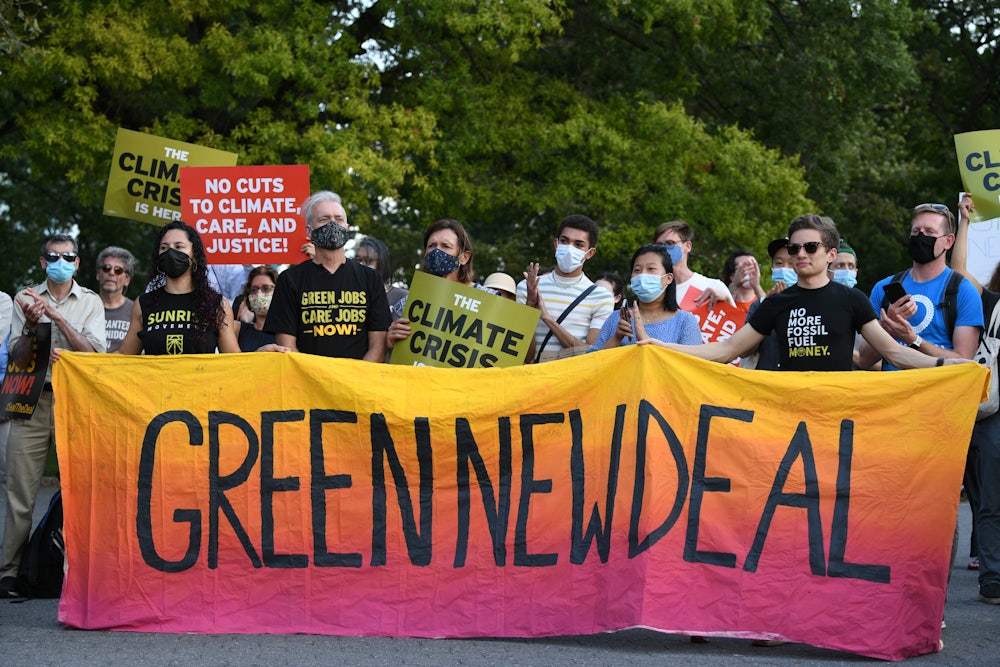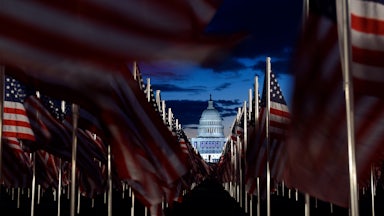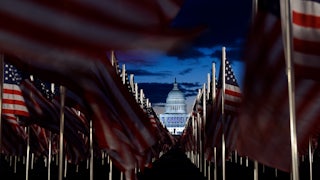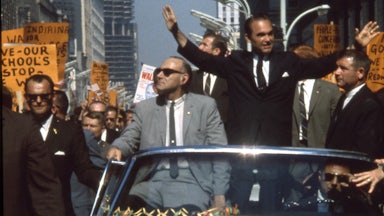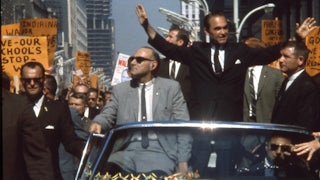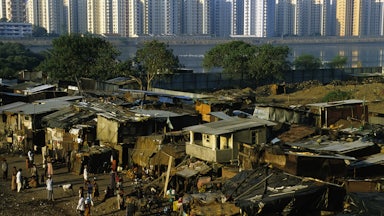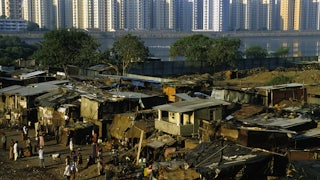Few have done more to change the climate paradigm than Rhiana Gunn-Wright. As an architect of the Green New Deal, Gunn-Wright was instrumental in expanding the limits of climate policy and telling a story far larger—and more inspiring—than that of how you can curb carbon emissions by taxing them. The Green New Deal’s vision: affirmative investment in green industries, decarbonization as an engine of economic growth, and racial equity and job creation at the center of the national project. On episode 7 of How to Save a Country, Gunn-Wright describes the astonishing scope of the original ask: “They wanted a World War II–style economic mobilization that would cut emissions in 10 years, create millions of jobs, and … reduce the racial wealth gap. And so my job was basically to figure out how you could do that.”
Now the director of climate policy at the Roosevelt Institute, Gunn-Wright sees the legacy of that vision in today’s politics. Environmental justice has become an essential part of the narrative, and industrial policy, which she has championed for years, is going mainstream. “Back in 2019 when I was doing all these interviews, it was like not a day went by where people didn’t ask me, ‘Well, why should equity be part of this? Why should racial justice be part of discussions about climate or decarbonization?’” Gunn-Wright recalls. “And now you can’t actually have a conversation about climate without mentioning equity and justice and environmental justice.”
On the show, Gunn-Wright also talks with hosts Felicia Wong and Michael Tomasky about why she thinks the Inflation Reduction Act is a mixed bag, why industrial policy must include transforming our approach to childcare and elder care, and how to change people’s understanding of where wealth comes from by telling a story of public investment and inclusion.
How to Save a Country is presented by the Roosevelt Institute, The New Republic, and PRX. Generous funding for this podcast was provided by the William and Flora Hewlett Foundation and Omidyar Network. Views expressed do not necessarily reflect the opinions and beliefs of its funders.
Reading recommendations
For more conversations Rhiana Gunn-Wright, see:
- “The Green New Heal with Rhiana Gunn-Wright”, from the America Dissected podcast with Abdul El-Sayed
- “How Climate Change and Environmental Justice Are Inextricably Linked,” an interview by the Washington Post
- “What Is Climate Justice? A Framework for Understanding the World,” an interview by Teen Vogue
- “How This Green New Deal Architect Gets It Done,” an interview by The Cut
Read Rhiana Gunn-Wright in Winning the Green New Deal, a collection edited by Varshini Prakash and Guido Girgenti of the Sunrise Movement. The collection features essays by Gunn-Wright, Joseph Stiglitz, and other activists, policymakers, and journalists who have helped transform the climate policy landscape. And check out Rhiana’s early-pandemic New York Times guest essay: “Think This Pandemic Is Bad? We Have Another Crisis Coming.”
Coming soon to a theater near you: Rachel Lears’ new documentary To the End, which chronicles Gunn-Wright, Varshini Prakash, Alexandria Ocasio-Cortez, and Alexandra Rojas in their fight for a Green New Deal. Learn more about the film—in theaters December 9—and watch the latest trailer.
Michael Tomasky: I’m Michael Tomasky, editor of The New Republic.
Felicia Wong: And I’m Felicia Wong, president and CEO of the Roosevelt Institute.
Michael: And this is How To Save a Country, our podcast on the ideas and the people contributing to a new political vision and a new economic vision for the United States. We connect to the economy, democracy, and freedom.
Felicia: Because progressives must have a common purpose and a common strategy to win.
Michael: One big piece of policy that’s trying to do all that, trying to reshape the economy as we know it, is the Green New Deal.
Felicia: The Green New Deal started out as a resolution a few years ago that actually made it to the floor of Congress. It was introduced by Representative Alexandria Ocasio-Cortez and Senator Ed Markey. It remains something really important in our politics because it’s a roadmap, a really ambitious roadmap, showing how the United States can reduce greenhouse gas emissions and wean ourselves from fossil fuels while at the same time revitalizing the economy with new jobs in green industry—and it links racial justice to climate justice.
Rhiana Gunn-Wright [clip]: Back in 2019 when I was doing all these interviews, it was like not a day that went by where people didn’t ask me, “Why should racial justice be part of discussions about climate or decarbonization?” Now, you can’t actually have a conversation about climate without mentioning equity and justice and environmental justice.
Michael: That’s our guest today, and she’s one of the people who crafted the Green New Deal: Rhiana Gunn-Wright.
Felicia: I’m really lucky to have Rhiana as my colleague. She’s the director of climate policy at the Roosevelt Institute. She can really tell us about climate provisions in the Inflation Reduction Act because the roots of today’s approach to climate, which are really different from the way we used to think about fighting climate change, those roots are in that Green New Deal. The basic idea is that you can use the government, the state, to affirmatively invest in particular industries—green manufacturing, decarbonization. That’s a Green New Deal idea, and, boy, it is different from how we used to think about fighting climate change, which was basically to tax carbon. Remember those days, Michael?
Michael: Oh yeah, very well. So let’s get to it. Rhiana Gunn-Wright, welcome to How to Save a Country.
Rhiana: Thank you. I’m excited to be here.
Michael: You grew up in Chicago, you grew up in Englewood, a neighborhood on the South Side, and it’s actually a neighborhood where we have learned air pollution and particulate matter levels are very high, some of the highest in the city. Did you gain an awareness of this growing up?
Rhiana: So I grew up, like you said, in Englewood. I was raised by my mom and my grandmother, actually, in the house that my mom grew up in. In a lot of ways I had a very idyllic childhood, in the sense of having a close-knit community. If I got As, I would get extra candy for Halloween. I had neighbors.
Felicia: You mean from all your neighbors? Not just from your mom?
Rhiana: Yeah, from neighbors. Because they would ask, they would know when report cards came out, so they would ask how you did and if you did well, they’d give you extra candy. So I grew up in a community that really felt like a community, but it was a pretty poor community on the whole. There was a fair amount of violence. At the time we didn’t know, but, like you said, it has some of the highest levels of particulate matter and air pollution in the city. So growing up I had asthma, and it was so common that I was in my twenties before I realized that it’s not a childhood disease. I was the policy analyst at the Detroit Health Department. One of the issues is there was an incinerator at the time in the middle of the city, and asthma rates around the incinerator were three times the state average. I was like, “Oh, so this level of asthma isn’t normal?” Like, it’s not normal for a bunch of kids to have asthma? It’s not normal for kids to be going to the hospital for asthma attacks? We would just take it as “Kids got asthma and you grew out of it,” and that was the first time I realized it wasn’t normal, and that some of the things that I was seeing in Detroit that I had seen in my own neighborhood.
Michael: So in between Chicago and Detroit, you were in New Haven because you went to Yale. You majored in African American Studies, is that right?
Rhiana: And women’s studies—women, gender, sexuality studies. My mother was so mad. She was convinced that I would never get a job. She was like, “I sent you to this Ivy League so you couldn’t get a job one day?”
Michael: Well, you showed her.
Rhiana: Sure did.
Michael: I think people would love to hear you talk about the Green New Deal, how you got involved and what exactly you did on the project.
Rhiana: Yeah, so I had just finished the Abdul campaign.
Felicia: This was in 2018, right?
Michael: Yeah, he was one of three candidates for governor in the Democratic primary of Michigan. He lost to the current governor, Gretchen Whitmer, but he was a physician.
Rhiana: Yeah. So we ran a campaign. We ran as progressives. One of the things that Abdul was very serious about was policy, and in particular, he’s very interested in environmental justice, so that’s where I first did work on environmental justice and public health, and also poverty. His focus is social determinants of health so he’s really interested in what are the parts of our systems that drive essentially ill health. So I was a policy director and we did a ton of policies. I was approached by a new think tank called New Consensus that was formed in part by one of the founders of Justice Dems.
Felicia: Who are the Justice Dems?
Rhiana: A political organization that tries to run basically everyday people and community champions for Congress. They were one of the first big groups, and they were new at the time, but they endorsed all of the members of “the Squad”: Alexandria Ocasio-Cortez, Ilhan Omar, Ayanna Pressley, and Rashida Tlaib at the time. The idea was that the squad, and in particular Representative Ocasio-Cortez, wanted to come out of the gate with a signature policy initiative in their first session of Congress to really take advantage of all the press that they were getting. They approached me and so I joined them and I basically was the research director for Green New Deal. They wanted a World War II-style economic mobilization that would cut emissions in 10 years, create millions of jobs, and also really press forward racial equity, really help reduce the racial wealth gap. So my job was basically to figure out how you could do that.
Felicia: When you think back on that period, what are you most proud of about the Green New Deal?
Rhiana: Back in 2019 when I was doing all these interviews, it was not a day that went by where people didn’t ask me, “Well, why should equity be part of this? Why should racial justice be part of discussions about climate or decarbonization? Isn’t that an add-on? Aren’t you just doing too much?” Now you can’t actually have a conversation about climate without mentioning equity and justice and environmental justice, right? Like the two now are tied together in both the public narrative, especially I think among Democrats, and also in terms of policy. I think there’s not enough money for environmental justice in the Inflation Reduction Act, but there is some—when I think in times before there might not have been any.
Felicia: Used to be all about carbon tax, not too long ago.
Rhiana: Right. All of a sudden, people don’t remember that and so I’m proud of that.
Felicia: I do. I do, but yeah.
Rhiana: I’m glad.
Felicia: But the conversation has changed.
Rhiana: A lot. And so I’m also proud of the conversation change because I think we had a lot to do with that. I’m also very proud of the fact that now we aren’t talking about carbon taxes, at least not in isolation, but there’s a real focus on industrial policy and decarbonization as an opportunity to build wealth for everyday folks and to do so in a way that is just and equitable. I don’t think we’re 100 percent there, but the fact that those are metrics and that is the approach, I think again, we had a lot to do with that. So I’m very proud of that.
Felicia: What are you most regretful about? Like what do you wish had happened that didn’t happen?
Rhiana: We also talked a lot and had a lot in even the Green New Deal resolution about social safety nets, about care, about healthcare, because again, as we were talking about systems happening at the same time, that’s one thing that we recognize, that you can’t have this economic transition be equitable if there’s not a social safety net. People can’t move for jobs without healthcare. Women can’t, especially after Covid, reenter without childcare, without some sense of how we’re going to split those care responsibilities. I think that those have gotten separated again and I think sometimes even we leaned really hard on discussions about manufacturing and, I will be honest, about the sort of “masculine” elements of the Green New Deal vision, because those resonate with people. I lived in Detroit at the time and was working on this. People have very fond memories even of the big three—the cars, factories—calling towards that is very resonant for people, and I know why we did that, but I wish, looking back, we had really continued to go hard around the care and social safety net elements of them, because they’re still very needed. But I think they have been excised from the conversation, or separated, again, in ways that I think are sad, especially because industrial policy is not just about building things, it’s also about the government helping to put its weight behind industries writ large that are helpful and that includes care.
Felicia: Right. I think we still think about investments in manufacturing and jobs and roads and bridges as “economic,” and I think we think about investments in care as social spending, and those are different categories in our heads, and they have different levels of worthiness, and I think those are very gendered.
Rhiana: Exactly.
Felicia: We’re going to take a quick break. When we return we’re going to talk about climate and the Inflation Reduction Act, but first we have a quick ask for our listener.
Michael: If you like the show, subscribe wherever you get your podcasts. Give us a rating. Give us a review.
Felicia: You know I’ve been looking at those reviews. Love ‘em, want more. That’s what I think, Michael. You can find us both on Twitter. I’m @FeliciaWongRI.
Michael: And I’m @MTomasky.
Michael: Welcome back to How to Save a Country. The Green New Deal isn’t law, obviously. Well, someday, someday. Three years later and much gnashing of Democratic teeth later, what is law is the Inflation Reduction Act. What’s your view of that?
Rhiana: Obviously it does of good things and makes investments, particularly in renewable energy and low-carbon goods that are really crucial and that promise to, at the very least, create a lot of jobs—that’s really great. There are investments and some priorities for the environmental justice movement, like toxic site cleanup. That’s really great. At the same time, some of it is attached to provisions—like the lease sales that say that you have to sell oil and gas leases on public land if you’re going to do solar and wind leases—that are so bad it’s almost comical. It feels a bit like a cartoon villain. Like I have rarely seen—I’m still wrapping my head around it because it is such a mixed bag. Some of the investments in technologies do in fact increase local pollution.
Michael: What are those? Can you talk a little bit more specifically about those?
Rhiana: In particular, there’s some concerns around hydrogen increasing local pollution, biofuels.
Felicia: These are all, in theory, cleaner alternatives that are being advanced by the IRA.
Rhiana: These are, in theory, cleaner alternatives. But again, that points to the IRA when they’re thinking about clean, they’re only thinking about carbon emissions, which is not all that comes with any of these energy sources. Particulate matter, pollution, that’s also a part of it, and then the other concerning thing that I know a lot of partners that we work with in environmental justice are concerned about is carbon capture and storage, mostly because of how it will be controlled by industry and also about how it could be used to continue to like to burn fossil fuel, so say putting CCS on a gas fire power plant that might otherwise be replaced with renewables.
Felicia: Sounds like you’re worried about it as a set of enabling devices in part.
Rhiana: Largely, yes. Having been in Detroit, I have seen people fight for years against fossil-fuel facilities and I know in particular there was one community that was fighting a Marathon Oil refinery, and the fumes were so bad that people couldn’t sleep at night. It took them years and years and years of fighting and of course there was a lot of misinformation, and so just having seen that upfront, I have real fears about what happens when those same facilities and companies have access to CCS with very few guardrails or accountability measures. So the IRA for me is in a lot of ways the definition of a mixed bag.
Michael: What do you think needs to be done for workers, people, regions of the country that have depended on fossil fuels—and we obviously have to move away from that fast—but what needs to be done for those folks?
Rhiana: Obviously you need to replace those industries. That’s easy to say and tougher to do, but I think that the first thing is there needs to be a real plan for federal support, likely for years, to help transition those areas, and support them through a transition, like just for instance, tax revenue. Transitioning away from those industries is important in terms of the climate, but that’s going to be a loss of tax revenue and for states and localities, that’s a big deal. It’s not that easy to replace tax revenue. They can’t print money.
Felicia: States, especially, can’t.
Rhiana: States can’t print money. There’s no sort of easing. And especially if you are in a balanced budget state, which means that you can’t spend more than you take in, you’re actually going to see, in real time, reductions to the level of services that states can provide. What that means to me is that there needs to be a lot of federal thinking about what does it mean to support regions as they transition. I also think really seriously about Justice 40.
Felicia: Yeah. Describe that.
Rhiana: Justice 40 is a federal initiative, still only created by executive action—so I would love to see that codified—but basically it says that 40 percent of climate and clean energy funding in seven areas, but they’re so large, it’s the vast majority of climate and clean energy funding, has to go to the benefit of disadvantaged communities. Justice 40 money should be going to those communities too and also there needs to be a real, small-d democratic effort to understand what just transition means for those communities as they define it.
Felicia: I’d love to hear you say a little bit about what some of the things that you actually like about the legislation really are and what you’re optimistic about.
Rhiana: My favorite part is the direct pay for basically publicly-owned renewables. I think that that is very cool.
Felicia: And what’s direct pay?
Rhiana: Direct pay, basically, it essentially turns the tax credit into a grant so you don’t need tax equity investors in the same way and it creates a real potential for public ownership of renewables and of energy, which is really, if you want decarbonization to be a wealth creation opportunity, particularly for communities that are often marginalized, ownership is a huge, huge part of that. I’m not a big fan of tax credits for a number of reasons, but I am a big fan of investments that are going to help the deployment of renewables and really speed up that deployment because the faster that deployment happens, the sooner we can start planning really seriously for transition away from fossil fuels because we need those alternative energy sources. Fossil fuels are a problem for a number of things, but even if you’re just talking about inflation, we’re always gonna be on this rollercoaster with fossil fuels until we can get off of them.
Felicia: Because the supply of fossil fuels is controlled by relatively few sources in regions of the world that are often quite authoritarian. You’re arguing that moving to clean electricity means that a more generally available and clean and abundant source of energy is possible, if we can make that transition, and that would smooth that pricing. That’s essentially what you’re arguing.
Rhiana: That would smooth out pricing. The only thing I would add is also that, because of that setup, we were at the stage where the biggest thing the president could do was write a strongly worded letter before the strategic reserve release. There’s not a whole lot—and that speaks to the difficulty of actually doing anything about fossil fuel pricing. The other thing is that electricity is a more regulated sector, so it’s much more difficult to have these large price spikes. There’s also funding to clean up buildings, I believe, in the IRA, which is really great. That’s a great way to drive down emissions. I have mixed feelings about the nationalist framing of reshoring industries. Sometimes I think I don’t like that, but I am excited about the chance for there to be vibrant economic hubs again, because I remember the way people’s eyes lit up when they talked about factories that their parents and grandparents had worked at and what that meant for them and I’m excited for other generations to be able to experience that hopefully. We haven’t talked about it but one of the biggest reasons for me that the IRA is a mixed bag is that a lot of what people talk about as compromises really fell on people of color, communities of color and Indigenous communities, and it was not with their consent, so it’s not so much a compromise as a sacrfice. To have a compromise both parties need to consent. I don’t know, it just made me really sad to see that in 2022. Until those concessions were made, there wasn’t a way forward. In so many ways, the same communities that have suffered so that we can use fossil fuels, we’re looking at legislation that will keep that suffering in place even as we try to build out renewables. That’s heartbreaking and I think really concerning, and something we all have to ask a question about, which is, when are those costs going to be unacceptable?
Michael: Rhiana, let me put to you what I think is the biggest challenge that your movement faces and this is trying to convince America that the changes that you are advocating for are good for the economy, will make the economy better, will help growth. I don’t think the American public quite understands that yet.
Rhiana: Yeah. I largely agree with your assessment. I’m not even sure how these linkages work, but even when I think about fossil fuels, there’s a linkage to prosperity in some ways. Just in having an abundance of oil and oil money there’s a sense of this is what makes you rich, and this is what has helped make us rich.
Felicia: Oil barons and tycoons and like in our culture—you’re too young, Rhiana, to remember the TV show Dallas.
Rhiana: I am, but I rewatched Dynasty on Amazon.
Felicia: So it’s all of that. This is the source of wealth, oil gushing from the ground. Rhiana: Oil gushing from the ground and all of that still calls to mind prosperity. I think that exists and it’s going to exist until there’s a new story to tell.
Felicia: What’s the story exactly that you imagine telling somebody as the solar farm or the wind turbines are being built in their communities? What would you say to them?
Rhiana: I think the story there is, were there jobs created? How many more of these are going up around the country? Who’s working there? Are they people who weren’t employed before? Was it someone who used to work at a fossil fuel factory? Was it someone who was able to get a job that now pays living wage that they didn’t have before? That’s the story that you need to be telling. How have people’s lives changed because of this solar farm? Telling that story alongside the story of how much carbon has been reduced because of this solar farm. Then the last part of this story that’s important is saying “This was made possible by public investment.” The habit now is to hide public investment. You don’t want to say that there was public money going to this, that makes it a target, but the new side of the story is saying that public investment did make this possible. The other thing that’s part of the struggle of the movement is making people think that this is profitable because the framing of this as profitable, as an engine of growth, like that is all from the movement. That is a discussion that is a framing of decarbonization and industrial policy that is directly attributable from the movement and the Green New Deal. The other side of that too, though, is telling a story about who all is included in this build out who might not have been included before and I think that’s where implementation really is going to be very crucial because these things do, in fact, need to happen justly. People of color, women, people who are not white men, who we often traditionally think of in these jobs—those folks need to be getting these jobs because if not building political power and affection and all the sort of things that you need to continue to do this will be a lot more difficult if it’s not clear that this is benefiting everyone.
Michael: The media narrative is simplistic and defined by a certain binary—“this versus that.” But I have to think that across the country, wind farms and solar panel construction facilities are actually being built and changing communities and changing people’s lives, are they not? This is happening. It’s just not on cable TV.
Rhiana: It’s happening more often, but I don’t think there’s this boom, which is what the IRA is aiming for and which will really help the narrative, if that’s what happens, is a boom where there’s a lot of this stuff happening in a short period of time and the benefits are very clear is what ultimately would be really helpful in terms of pushing a message is that this is prosperous. The last part that we have to actually talk about and make sure we tell the story of is how was this stuff built justly. Because the other thing that we don’t want to happen is that there’s a narrative that things like environmental review, that elements of the process that should protect people, that they’re nothing but a nuisance. If that takes hold, even if we have a greener economy, how much different is that than neoliberalism before? That’s another huge important story to tell is that we built things and we didn’t sacrifice our ecosystem or any people to do it. Because that’s still a story that we cannot tell in America, largely. And it makes people act as though the sort of tradeoffs in the IRA are inevitable, because we don’t have a history of building things without exploiting or sacrificing people. In instances where that does happen, it’s really important to hold that up so that people know it’s possible and so it’s not taken as a ridiculous landmark to say, “Hey, actually marginalized folks shouldn’t suffer because this needs to happen.”
Felicia: We can tell the story when we show it’s true and by telling the story, we can make it true.
Rhiana: Exactly.
Felicia: So Rhiana, the last question: This show is called How to Save a Country. Rhiana Gunn-Wright—don’t laugh, Rhiana, we are serious! You are serious about this. OK, Rhiana Gunn-Wright, how would you save our country?
Rhiana: Oh, how? Which part of it? I talk about white supremacy a lot, sorry. But when I think about how to save our country, I really do think first about white supremacy and how do we move away from a reliance on white supremacy to sort “solve problems” like we did in the IRA. We relied on sacrificing certain communities to get this deal across the line. Even if you look at industrial policy as we’re approaching it now, if we don’t implement it well, that this is about how do we build a green economy while still keeping in place white privilege, especially economic privilege. And so I think that to save our country, we actually have to embrace that there is a way to solve the problems that we face that don’t rely on white supremacy, that those things actually exist. They might look very different from what we’re used to. They might require us to make decisions that we’ve never made before. But that it is, in fact, possible and preferable.
Felicia: Rhiana, the idea that we can save all of us by weaning us from the existing power structures, which are, as you often point out, white supremacist, that is a very powerful idea. I just want to thank you for your time on our show and for the time that you’ve spent making ideas like a Green New Deal part of our more common narrative, and ever closer to part of our reality. So thank you, Rhiana Gunn-Wright.
Rhiana: Oh, you’re so welcome.
Felicia: Rhiana is such a big thinker and she takes the conversation in so many different places. One of the things that strikes me is what she ended our conversation with: the idea to save our country, we need to move past an era of white supremacy. I don’t want to put words in her mouth, but here’s how I think about white supremacy.
Michael: Let’s have it.
Felicia: It’s the idea that we are trying to build new systems—Inflation Reduction Act, Green New Deal, whatever our new system is—we’re trying to build it on top of a set of laws that has systematically advantaged people who are white. So it’s about trying to move past that with affirmative policies that repair some of that before they also try to move forward with a kind of more inclusive, opportunity-focused agenda of growth.
Michael: Yeah, that sounds right. I mean, I relate it to authors like our friend Heather McGee and Dorothy Brown and Richard Rothstein, The Color of Law.
Felicia: Dorothy Brown, the tax lawyer.
Michael: Dorothy Brown, the tax lawyer—a great book on how the tax code was structured through lobbying by white people and white groups to get certain advantages. Rothstein described a way in which all these laws, housing segregation particularly, advantaged white people, and those laws have been taken off the books, true, but no replacement laws have been passed to affirmatively change those advantages.
Felicia: Right, and I do think that in order to move forward in this way that is both inclusive and green, which is of course everything that Rhiana is arguing for, we need to take a look at that system of older laws and the ways in which they still structure our lives. That’s what it means to me to move beyond this era of white supremacy.
Michael: Yep, I agree. It’s very important. I guess my takeaway has to do with how we convince average Americans that a green economy is an economy of growth. People on the right will always say, “This is a job killer. This is awful for the economy. This is going to take away your job.” Then they add things like, “You’re not gonna be able to fly on an airplane,” and stuff like that, which is a whole different set of things. The core argument that the green left, as it were, needs to make is to show people how this is going to be good for the economy, how it’s going to create jobs, how it’s going to improve growth, that I think is the big job.
Felicia: Indeed.
Michael: Yeah.
Felicia: Next week we are going to be doing things a bit differently.
Michael: It’s just going to be Felicia and me breaking down the results of the midterms. We’re going to have a conversation that’s in keeping with the mission of this show that talks about how these things that we try to discuss on this program played out in the election and what the post-election state of play is with respect to these economic and political questions.
Felicia: I am hopeful that we’ll find places where candidates really were able to talk about the job creation work or the public investment work of this new economic paradigm in ways that were effective.
Michael: There’s bound to be one.
Felicia: But we’ll talk more about why that is next week on How to Save A Country.
How to Save A Country is a production of PRX in partnership with the Roosevelt Institute and The New Republic.
Michael: Our coordinating producer is Cara Shillenn. Our lead producer is Alli Rodgers. Our executive producer is Jocelyn Gonzalez and our mix engineer is Pedro Rafael Rosado.
Felicia: Our theme music is courtesy of Codey Randall and Epidemic Sound with other music provided by APM. How to Save a Country was made possible with support from Omidyar Network, a social change venture that is reimagining how capitalism should work. Learn more about their efforts to recenter our economy around individuals, community, and societal wellbeing at omidyar.com.
Michael: Support also comes from the Hewlett Foundation’s Economy and Society Initiative, working to foster the development of a new common sense about how the economy works and the aims it should serve. Learn more at hewlett.org.
